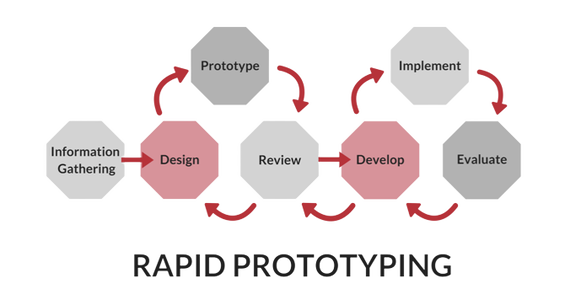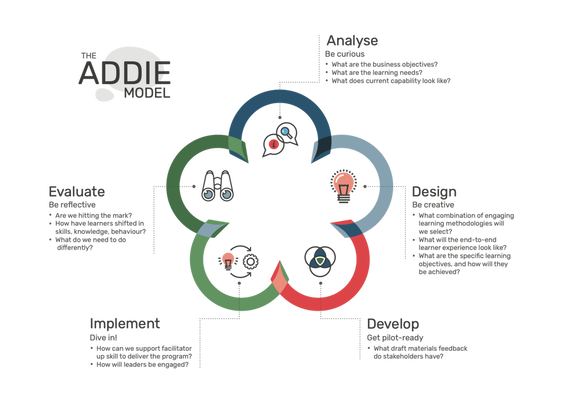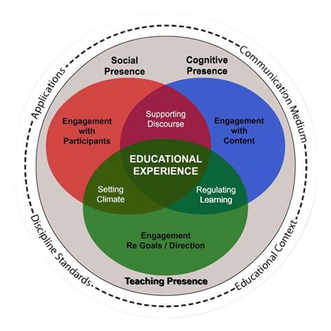Start with an Instructional Design Model
|
The development of any learning program, including skills training, onboarding, how-to instruction, and for-credit or informal courses (online or in-person) should begin with a design framework. A framework, also referred to as an instructional design model, saves time in the long run and lays the foundation for an effective learning and teaching experience for all: learners, educators, and other stakeholders.
Now which model should you choose? Fortunately, but also unfortunately, there are several. All models worth their salt should include the following elements: i) conducting a needs assessment; ii) establishing objectives and goals; iii) selecting and designing materials and instructions; iv) implementing and testing; and v) evaluating the program and outcomes. I have used numerous models over the years; below I share my top recommendations. |
Dick and Carey Model
The most comprehensive model that instructional designers have used for years due to its solid methodology is the Dick and Carey Model of Design. It is used for developing training and development programs in corporations and educational institutions due to its excellent and reliable outcomes. It is applicable to any type of skills training or higher education undergraduate credit courses.
One downside is that it can be time-consuming and, some say, inflexible, given the upfront time investment before the program can be tested. I used this extensively at the beginning of my career, mainly for employee training and onboarding programs, and can attest to its comprehensiveness and solid outcomes. You can learn more here, at Penn State's website. The website also features an Instructional Design Handbook by Pressbooks.
The most comprehensive model that instructional designers have used for years due to its solid methodology is the Dick and Carey Model of Design. It is used for developing training and development programs in corporations and educational institutions due to its excellent and reliable outcomes. It is applicable to any type of skills training or higher education undergraduate credit courses.
One downside is that it can be time-consuming and, some say, inflexible, given the upfront time investment before the program can be tested. I used this extensively at the beginning of my career, mainly for employee training and onboarding programs, and can attest to its comprehensiveness and solid outcomes. You can learn more here, at Penn State's website. The website also features an Instructional Design Handbook by Pressbooks.
Rapid Prototyping Model
The goal of this model is to shorten the design process by getting feedback at the initial stages and allowing developers to adjust and adapt the learning strategy. It works best with open and frequent channels of communication between "testers" and developers. I like this design because of its adaptive nature, but I found that getting quality feedback and adapting was time-consuming (the opposite of rapid). But with effective implementation, outcomes are excellent. Learn more about the model at instructional design.org.
The goal of this model is to shorten the design process by getting feedback at the initial stages and allowing developers to adjust and adapt the learning strategy. It works best with open and frequent channels of communication between "testers" and developers. I like this design because of its adaptive nature, but I found that getting quality feedback and adapting was time-consuming (the opposite of rapid). But with effective implementation, outcomes are excellent. Learn more about the model at instructional design.org.
ADDIE: Analyze, Design, Develop, Implement, and Evaluate
ADDIE is the most generic model in the realm of instructional design due to its straightforward principles. It is user-friendly, good for educational settings, and excellent for skills training. My criticism is that learning objectives are addressed in the first phase of the needs analysis, which, should be an open-ended and inquisitive process. Overall, it is a solid model. You can find out more about it here.
ADDIE is the most generic model in the realm of instructional design due to its straightforward principles. It is user-friendly, good for educational settings, and excellent for skills training. My criticism is that learning objectives are addressed in the first phase of the needs analysis, which, should be an open-ended and inquisitive process. Overall, it is a solid model. You can find out more about it here.
Create Opportunities for Student Engagement
|
Community of Inquiry (CoI) Framework
This framework was developed during a Canadian Social Sciences and Humanities research-funded project and addresses the need for student engagement and teacher presence. Incorporating CoI principles into learning programs should be addressed in the development phase of the instruction design process. I have seen how CoI principles increase student engagement and lead to better outcomes. The CoI framework considers students' needs for: (i) social interaction; (ii) cognitive challenge and rigor; and (iii) teacher interaction and feedback. The three work in tandem to create an effective educational experience. You can read more about the CoI framework at University of Athabasca's dedicated site. |
Course Evaluation
Chico's Course Evaluation Rubric
Evaluating course design is essential. I have used Chico State University’s rubric extensively over my career. It is a tool that I recommend using during the design process as well as after. The rubric has six categories, including course development, student interaction opportunities, learner resources, and more. It is most helpful to consult at the beginning of the course development process as well as at the conclusion. I highly recommend this tool: click here to download the PDF. To learn more about the rubric visit Mt. Sac Library's site here.
Evaluating course design is essential. I have used Chico State University’s rubric extensively over my career. It is a tool that I recommend using during the design process as well as after. The rubric has six categories, including course development, student interaction opportunities, learner resources, and more. It is most helpful to consult at the beginning of the course development process as well as at the conclusion. I highly recommend this tool: click here to download the PDF. To learn more about the rubric visit Mt. Sac Library's site here.
Recommended Resources
- Big Dog & Little Dog’s Performance Juxtaposition is a robust site hosted by Don Clark, an experienced educator and performance consultant. It includes links with excellent content specific to instructional design, learning, performance, teaching and more.
- Penn State's College of Earth and Mineral Sciences hosts this site, Instructional Design Resources. It features a hefty list of links to sites, free books and resources for instructional design, online teaching, and evaluation.
- Instructionaldesign.org is an excellent starting point for researching instructional design models, strategies and learning theories.
- Online Learning Insights is my own blog that is dedicated to articles about course design, learning theories, and teaching for online courses.



